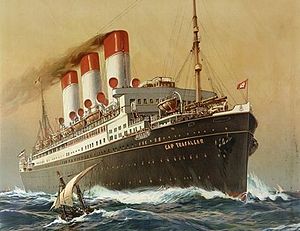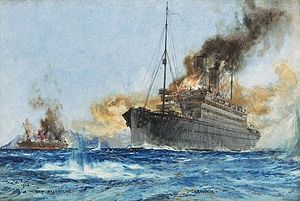SMS Cap Trafalgar

| |
| History | |
|---|---|
| Name | Cap Trafalgar |
| Namesake | Cape Trafalgar |
| Owner | Hamburg Südamerikanische Dampfschifffahrts-Gesellschaft |
| Builder | AG Vulcan, Hamburg |
| Yard number | 334 |
| Launched | 31 July 1913 |
| In service | 1 April 1914 |
| Homeport | Hamburg |
| Fate | Sunk in combat, 14 September 1914 |
| General characteristics | |
| Tonnage | 18,710 GRT |
| Displacement | 23,640 tons[1] |
| Length | 613 ft (187 m) |
| Beam | 72 ft (22 m) |
| Installed power | 15,000 shaft horsepower |
| Propulsion | Twin steam 4-cylinder triple expansion engines with turbines; 3 propellers |
| Speed | 17 knots |
SS Cap Trafalgar was a German ocean liner launched in 1913 for the Hamburg Süd line. In 1914, she was converted for use as an auxiliary cruiser during World War I. She was the first armed merchant cruiser sunk by a ship of the same class; she was destroyed by HMS Carmania,[2] also a converted ocean liner, in a furious action in the South Atlantic on 14 September 1914. It was the world's first battle between former ocean liners.[3]
Early career
[edit]The passenger liner SS Cap Trafalgar was built at the AG Vulcan Shipyard on the Elbe River in Hamburg, Germany for the Hamburg-South America Line for their service between Germany and the River Plate (Río de la Plata). She was named after the Spanish Cape Trafalgar, scene of the famous Battle of Trafalgar in 1805. A three-funneled vessel of 613 ft (187 m) length and 72 ft (22 m) beam, she measured 18,710 GRT and could carry nearly 1,600 passengers (400 1st class, 276 2nd class, 913 3rd or steerage class. A triple-screw vessel, her outer propellers were powered by two triple-expansion steam engines with the centre one driven by an exhaust turbine.[4][5]
When Cap Trafalgar began her maiden voyage on 10 April 1914 from Hamburg for South American ports in Brazil, Argentina and Uruguay, she was the largest vessel traveling on the South American service and among the most luxurious.[4][5] Her upper decks included a swimming pool and a cafe in a greenhouse while her 1st class halls and stairwells were full of beautiful gold filigree, and her staterooms were furnished in the highest fashion of the period. She was the epitome of pomp, elegance, and Germanic engineering but when war was declared, her career among the socialites and wealthy of the world ended.[6]
Sinking
[edit]| Sinking of SMS Cap Trafalgar | |||||||
|---|---|---|---|---|---|---|---|
| Part of Atlantic U-boat campaign of World War I | |||||||
 Carmania sinking Cap Trafalgar | |||||||
| |||||||
| Belligerents | |||||||
|
|
| ||||||
| Commanders and leaders | |||||||
|
|
| ||||||
| Strength | |||||||
| SMS Cap Trafalgar | HMS Carmania | ||||||
| Casualties and losses | |||||||
|
| ||||||


When war was declared in Europe in August 1914, Cap Trafalgar was in Buenos Aires and was laid up pending orders. As already planned, the German Imperial Navy requisitioned her as an auxiliary cruiser. On 18 August she arrived in Montevideo for coal and then sailed to rendezvous at the remote Brazilian island of Trindade, 500 miles (800 km) east of the Brazilian mainland, with the gunboat SMS Eber, which transferred naval officers, ammunition and armaments to the liner. At the same time, her third funnel, which was a dummy, was removed. She was armed with two 4.1 inch guns and six one-pounder pom-poms (named for the sound they made while firing), all manned by experienced naval personnel, and given the mission to sink British merchant shipping.[5][7] She was given the codename Hilfskreuzer B (Auxiliary Cruiser B) and was commanded by Korvettenkapitän Wirth. After a fruitless initial cruise, Cap Trafalgar returned on 13 September to the secret supply base at Trindade Island to take on fuel from German colliers.[citation needed]
The RMS Carmania was a British ocean liner designed by Leonard Peskett and built by John Brown & Company for the Cunard Line. She was launched on 21 February 1905 and made her maiden voyage from Liverpool to New York on 2 December of the same year. Following the outbreak of World War I, Carmania was converted into an armed merchant cruiser, equipped with eight 4.7-inch guns, and put under the command of Captain Noel Grant.[8]
It was at this base on 14 September that Cap Trafalgar was discovered by the Carmania which had been sent to flush out German colliers and small warships that might be using the inhospitable island as a base against British merchant shipping. Carmania spotted Cap Trafalgar's smoke early in the morning and some hours later was able to surprise the German ship with two colliers in the island's only harbour.
The Cap Trafalgar (disguised as the Carmania)'s only battle was against the real Carmania.[9] Some accounts incorrectly allege that the Carmania was itself disguised as the Cap Trafalgar.[a]
Both the captains of the Cap Trafalgar and the Carmania had realized that to fight a successful action, their respective vessels required plenty of room; so, the captains had separately steamed several miles from the outcrop of the Island of Trindade in order to gain the space required. The Cap Trafalgar also sent out encoded German messages, announcing the engagement with the Carmania, and the position as 35 degrees west, 26 degrees south, with a NNW heading. Then the two ships turned towards each other and began to fight, the Carmania firing too early and thus allowing the Cap Trafalgar to land the first blow. Carmania fared worse than her opponent in the ensuing two hours,[dubious – discuss] being hit 79 times, was holed below the waterline, and had her bridge totally destroyed by shellfire. However, as the range closed her own guns began to inflict damage, and fires broke out on both ships, sailors lining the rails and firing machine guns at their opposite numbers as the ships came within a few hundred yards of each other. Neither ship had the fire control systems or ammunition hoists of a modern warship, so the action was fought in the style of Nelson's day, with ammunition being brought to the guns by hand and the guns firing as the target bore.[11]
Just as it seemed that the fires on Carmania would burn out of control, Cap Trafalgar veered away, lowering lifeboats as she heeled over to port. A shell below the waterline had ruptured several compartments, and the ship was rapidly sinking, although the colliers were able to rescue 279 sailors from the wreck before she sank. Fifty-one were killed in the fighting or the sinking (other reports[which?] say sixteen or seventeen people died), including Captain Wirth. Carmania was equally damaged, listing severely, heavily flooded and burning, with nine men dead and many more wounded. It was at this point that Cap Trafalgar's contemporary, the armed merchant cruiser SS Kronprinz Wilhelm arrived, seemingly to provide the coup de grace for the shattered ship. However, the Kronprinz Wilhelm's captain feared a trap, since many ships both German and Allied in the area had doubtless been listening to the SOS calls of the Cap Trafalgar, which, though in German code, had been supplemented by messages from the Carmania with the British code. Since multiple warships were on their way to the location, and the Cap Trafalgar had presumably already sunk, the captain of the Kronprinz Wilhelm turned his ship about and sailed away without firing a shot.[citation needed]
The Carmania was barely afloat. She listed severely as fires burned and the communication and navigation equipment on her bridge were almost destroyed. She turned away and sped south, hoping to rendezvous with a British cruiser in the area. By the time she was rescued on the 15th, she was hardly seaworthy and most likely would have sunk if at sea for more than another day or two. The following day the Carmania was rescued and brought into Pernambuco by other units of the Royal Navy, whilst the survivors of the Cap Trafalgar were rescued by the collier Eleonore Woermann and taken to Buenos Aires. Most were interned for the duration of the war on the Argentine island of Martín García.[4]
See also
[edit]Notes
[edit]- ^ "In a twist of incredible irony, the crew of the Cap Trafalgar, in an attempt to disguise their ship, had altered her appearance so that she would closely resemble one of the 'Pretty Sisters.' (Though it would later be said that the Carmania had also altered her appearance so that she might be mistaken for the Cap Trafalgar, there is no truth to the claim.)"[10]
Citations
[edit]- ^ Schmalenbach p48
- ^ SUPPLEMENT to The London Gazette Of TUESDAY, the 6th of APRIL, 1915. p. 3550.
For services in the action between H.M.S. "Carmania" and the German Armed Merchant Cruiser "Cap Trafalgar," on 14th September, 1914, when the latter vessel was sunk—
- ^ Robert K. Massie (2003). "Ch. 11. Admiral Cradock's Voyage". Castles of Steel: Britain, Germany, and the Winning of the Great War at Sea. Ballantine Books.
Quote: Cap Trafalgar fired back, and the world's first battle between ocean liners began.
- ^ a b c Cooper, James; Arnold Kludas; Joachim Pein (1989). The Hamburg South America Line. Kendal: The World Ship Society. pp. 13–14, 64. ISBN 0-905617-50-9.
- ^ a b c Bonsor, N R P (1983). South Atlantic Seaway. Jersey: Brookside Publications. pp. 194–195, 213, 494. ISBN 0-905824-06-7.
- ^ "Battle between the Carmania and the Cape Trafalgar". wartimehistoryonline. 17 March 2017. Archived from the original on 10 January 2018. Retrieved 9 January 2018.
- ^ Hocking, Charles (1969). Dictionary of Disasters at Sea during the Age of Steam. London: Lloyd's Register of Shipping. p. 119.
- ^ "S/S Carmania, Cunard Line". Norway Heritage. Archived from the original on 25 March 2019. Retrieved 9 January 2018.
- ^ "'Carmania' sinking the 'Cap Trafalgar' off Trinidade Island in the South Atlantic, 14 September 1914". Royal Museums Greenwich (Collections). National Maritime Museum. Archived from the original on 13 December 2013. Retrieved 18 February 2013.
- ^ Butler, Daniel Allen (2004). "The Great War". The Age of Cunard : A Transatlantic History 1839-2003 (1st ed.). Annapolis, MD: Lighthouse Press Publication. p. 209. ISBN 9781577853480.
- ^ Various. "The Illustrated War News, Nov. 18, 1914". Number 15, p. 21. Project Gutenberg. Archived from the original on 28 August 2020. Retrieved 24 October 2010.
References
[edit]- Edwards, B. (1995). Salvo! Epic Naval Gun Actions. Cassell. ISBN 0304351717.
- Simpson, C. (1977). The Ship That Hunted Itself. Penguin Books. ISBN 0140048235.
- Schmalenbach, P. (1979). German raiders: A history of auxiliary cruisers of the German Navy, 1895-1945. Naval Institute Press. ISBN 0870218247.
- Niezychowski, A. (1928). The Cruise of the Kronprinz Wilhelm.
External links
[edit]- Shipwrecks in the Atlantic Ocean
- Ocean liners
- World War I cruisers of Germany
- World War I commerce raiders
- Passenger ships of Germany
- World War I shipwrecks in the Atlantic Ocean
- Maritime incidents in September 1914
- Auxiliary cruisers of the Imperial German Navy
- Naval battles of World War I involving the United Kingdom
- Naval battles of World War I involving Germany
- Maritime incidents in Brazil
- Conflicts in 1914
- Atlantic operations of World War I
- 1913 ships

